Sauropod dinosaurs were just generally weird animals, but there’s something… not quite right about Atlasaurus imelakei.
Named after the Atlas Mountains of Morocco where its fossil remains were discovered, Atlasaurus lived during the mid-Jurassic period, around 168-165 million years ago. While it wasn’t the strangest–looking sauropod by any means, compared to other species its body proportions still show a particularly bizarre combination of features, with a slightly bigger head, unusually short neck, and very long slender legs that made up nearly half of its 9m height (29’6″).
It’s sort of the uncanny valley of sauropods. Everything about it is just a tiny bit wrong.

Its tall shoulders and sloping back resemble the body plan of brachiosaurids so closely that it was initially thought to be an early member of that group, but more recent studies suggest it may have been part of an earlier evolutionary branch of sauropods known as the turiasaurs – which would mean its brachiosaur-like shape was actually the result of convergent evolution.
But what was it doing with such weird proportions?
…We really don’t know. Other short-necked sauropods seem to have been adapted for feeding on lower vegetation only a couple of meters off the ground, but Atlasaurus’ leggy build would have made it a high browser like the brachiosaurids it was mimicking. Its long legs may also have allowed it to move faster, or given it some advantage navigating over rough terrain, but since no other sauropod ever seemed to evolve this way it must have been doing something particularly unique.
Or perhaps it was just an evolutionary fluke. Maybe part of a lineage that had started adapting to short-necked low browsing, then moved back towards the high browsing niche – and happened to end up lengthening their legs instead of their necks to get the necessary height back.














